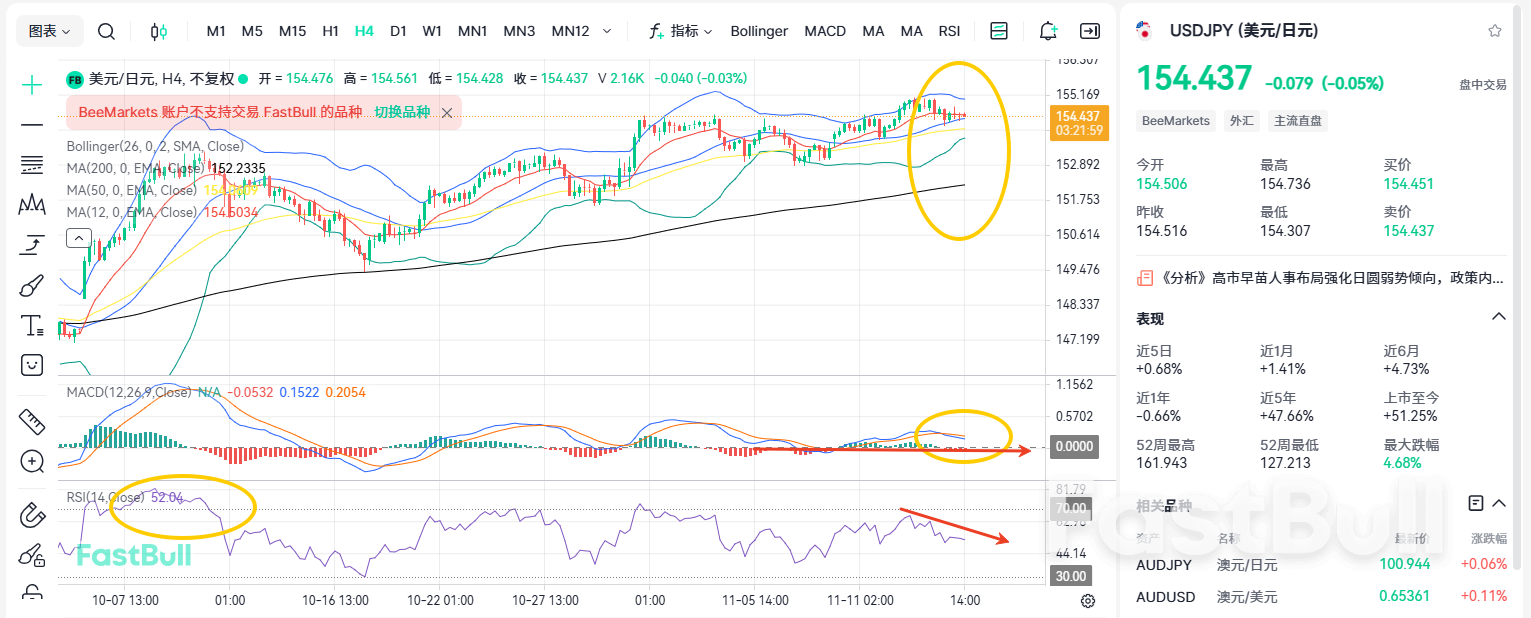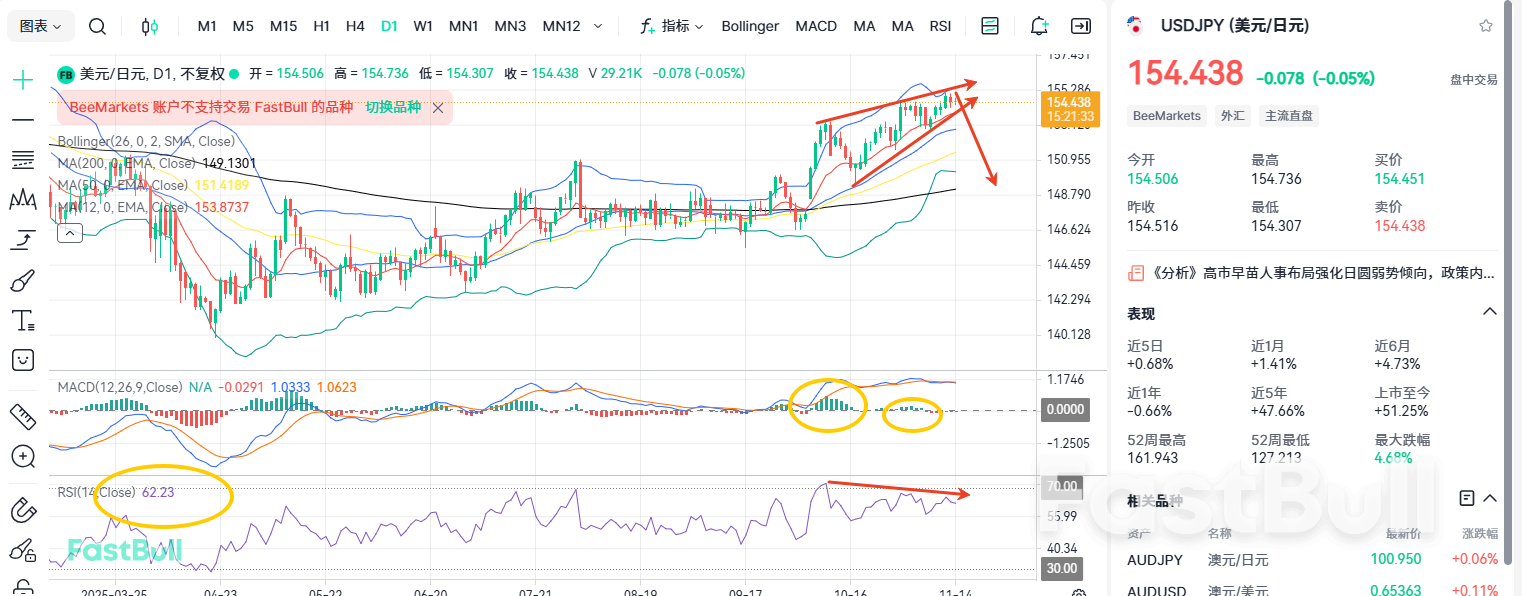Fundamentals
Influenced by rising food prices, Japan's wholesale price index in October exceeded market expectations, indicating persistent inflationary pressures and potentially increasing the Bank of Japan's (BOJ) difficulty in resuming interest rate hikes. Data shows that due to high rice and other food prices, Japan's corporate goods price index rose by 2.7% year-over-year in October, slightly below September's 2.8% but still surpassing the forecasted 2.5%. Although import prices in yen declined by 1.5% YoY, rising domestic food and non-ferrous metal prices contributed to the overall increase in wholesale prices. Analysts suggest that if Prime Minister Sanae Takaichi's government proceeds with policies to reduce utility costs as part of stimulus measures, wholesale inflation could slow. However, expansionary fiscal policies may also weaken the yen, elevating import costs and maintaining upward pressure on inflation. Kazuo Ueda further emphasized in the Diet that domestic consumer resilience, the tightening labor market driving wage growth, and the resulting moderate increases in wages and prices constitute a positive feedback loop. Aside from raw material cost inflation, rising prices in the service sector and other goods reflect underlying economic recovery momentum. He believes that core inflation, excluding temporary factors, is accelerating, indicating that Japan is progressing toward the 2% inflation target. However, the BOJ's policy capacity is constrained by government fiscal expansion. Since ending the monetary easing measures implemented during Kuroda Haruhiko's tenure, the BOJ has raised short-term interest rates twice to 0.5% but has maintained stability to assess impacts from global economic shifts. Analysts suggest that the BOJ is attempting to adjust interest rates toward a neutral level—approximately 1% to 1.5%—though large-scale government expenditure plans and appointments of officials supporting accommodative policies may delay this adjustment. Fiscal expansion has raised market concerns, pushing long-term bond yields higher and contributing to yen depreciation, which in turn escalates import costs and inflationary pressures. Some former policymakers warn that this trend could undermine household purchasing power and threaten the sustainability of Japan's economic recovery.
The U.S. on the other side of the Pacific faces ongoing economic and policy uncertainties. After a record-breaking 43-day government shutdown, the federal government has finally reopened. During the impasse, air traffic was disrupted, food assistance programs were interrupted, and over a million federal employees experienced prolonged unpaid leave. Although Congress approved funding through an appropriations bill extending until the end of January next year, core partisan disagreements remain unresolved. Within the Democratic Party, fissures have emerged over strategies toward the Trump administration, with progressives demanding a tough stance and moderates advocating for pragmatic collaboration. Polling indicates that the shutdown has negatively impacted public opinion for both parties. The Congressional Budget Office estimates a 1.5% decline in U.S. GDP, approximately US$50 billion in delayed expenditures, with US$14 billion of losses deemed irrecoverable. Disruptions to economic data releases have complicated Federal Reserve and investor assessments of the economic outlook, adding uncertainty to holiday spending behavior. In this context, Federal Reserve officials exhibit increased caution regarding future policy adjustments. Federal Reserve Chair Mary Daly indicated that the risks between achieving price stability and employment goals have become balanced, leading to an open stance on the possibility of a rate cut in December. She emphasized that future policy decisions will depend on newly released data, and it is premature to assert a rate cut at this stage. Despite inflation not yet stabilizing at 2%, the labor market shows some signs of softening. Consequently, market expectations for a December rate reduction have decreased significantly from 67% to 47%. Other officials, such as Minneapolis Fed President Kashkari and Boston Fed President Collins, also expressed cautious views, suggesting that policy easing should only occur if employment deteriorates substantially. Federal Reserve Chair Jerome Powell stated that a rate cut in December is "far from certain", citing data uncertainties caused by the government shutdown. Market analysts believe that there is no consensus within the Fed on the next policy direction, with balancing inflation and employment remaining a primary consideration.
Technical Analysis
In the 1D timeframe, the Bollinger Bands are expanding upward, with the SMAs diverging, indicating an ongoing bullish trend. However, the candlestick pattern forms a wedge, and the MACD momentum is diminishing, while the RSI stands at 62, reflecting strong bullish market sentiment. Nonetheless, the recent highs are progressively declining, suggesting a probable correction to the EMA12 or the middle band of the Bollinger, at levels of approximately 153.8 and 152.8, respectively. In the 4H timeframe, the Bollinger Bands are contracting, and the SMAs are flattening. After the MACD formed a death cross, the MACD line and signal line are beginning to reapproach the zero-axis, currently at a considerable distance, indicating that the correction phase is still underway. The RSI is at 52, signifying that market participants are largely in a wait-and-see stance. Should the price break below the middle Bollinger band, a correction toward the EMA200 at approximately 152.2 is probable; conversely, if the price maintains above the middle band, further upward movement towards 156 is likely. It is recommended to go short initially before going long in the short term.


Trading Recommendations
Trading Direction: Sell
Entry Price: 154.6
Target Price: 151.4
Stop Loss: 156
Support: 150, 148.5, 146.6
Resistance: 155, 156.7, 158.8














